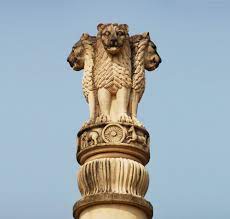Q. Discuss the significance of the lion and bull figures in Indian mythology, art and architecture.
Ans: Lion and bull figures hold significant symbolism in Indian mythology, art, and architecture. They are often associated with various deities, stories, and cultural representations, showcasing their importance and widespread presence in Indian heritage.

Lion:
- Symbol of Power and Royalty: In Indian mythology, the lion is often associated with power, courage, and royalty. Lions are seen as majestic and regal creatures, making them symbolic of strength and authority.
- Guardianship and Protection: Lions are frequently depicted as guardians or protectors in art and architecture. They are often placed at the entrances of temples, palaces, and important buildings to ward off evil and ensure safety.
- Divine Figures: In Hindu mythology, the lion is associated with various deities. For instance, Goddess Durga is often depicted riding a lion, symbolizing her fearless nature and ability to conquer evil forces.
- Narasimha Avatar: Lord Vishnu’s Narasimha avatar, where he takes the form of a lion-headed man, represents a powerful fusion of human and animal attributes. This avatar is associated with protection and the destruction of evil forces.
- Asoka Pillars: The lion capital atop the Ashoka Pillar at Sarnath is one of the most iconic symbols of ancient India. It represents the Mauryan Empire and reflects Ashoka’s commitment to dharma, justice, and the welfare of his subjects.
- Sculptures and Statues: Lion sculptures are commonly found in ancient temples and historical sites across India. They serve as ornamental elements and carry religious and cultural significance.
Bull:
- Symbol of Fertility: In Indian mythology, the bull is often associated with fertility and abundance. It is seen as a symbol of life-sustaining forces in nature.
- Vehicle of Lord Shiva: The bull, known as Nandi, is the devoted vehicle of Lord Shiva. Nandi is often depicted sitting in front of Shiva temples, symbolizing devotion and steadfastness.
- Ploughing and Agriculture: In rural contexts, the bull has associations with agriculture and ploughing, reflecting its importance in sustaining livelihoods and food production.
- Bull as Dharma: The story of the bull and the lion in the Panchatantra highlights the values of friendship, loyalty, and righteousness. This tale emphasizes the significance of dharma in human relationships.
- Bull Motifs in Architecture: Bull motifs are commonly seen in Indian temple architecture and carvings. They add artistic and symbolic value to the structures, highlighting their role in cultural and religious contexts.
- Nandi Statues: Nandi statues are a common feature in Shiva temples. Devotees often offer prayers to Nandi as a way of seeking blessings and guidance from Lord Shiva.
Overall, the lion and bull figures in Indian mythology, art, and architecture are deeply intertwined with cultural, religious, and philosophical meanings. They reflect the diverse symbolism and rich narratives present in Indian heritage, contributing to the multi-dimensional tapestry of India’s cultural and artistic expressions.